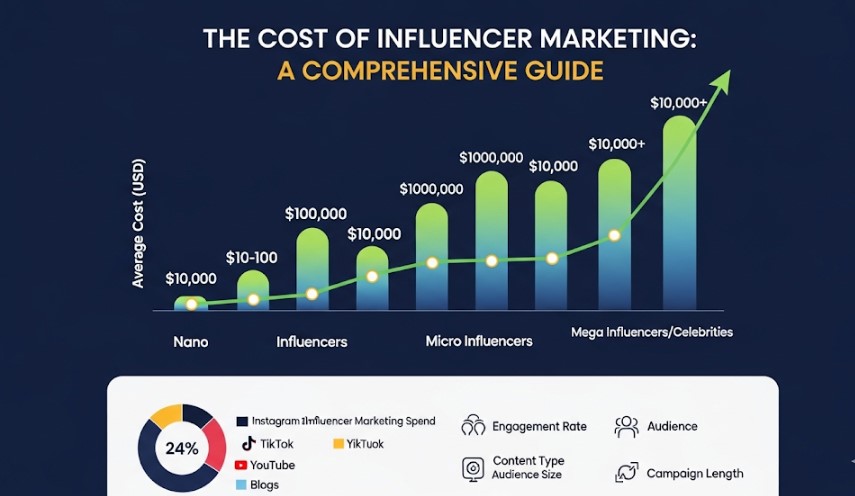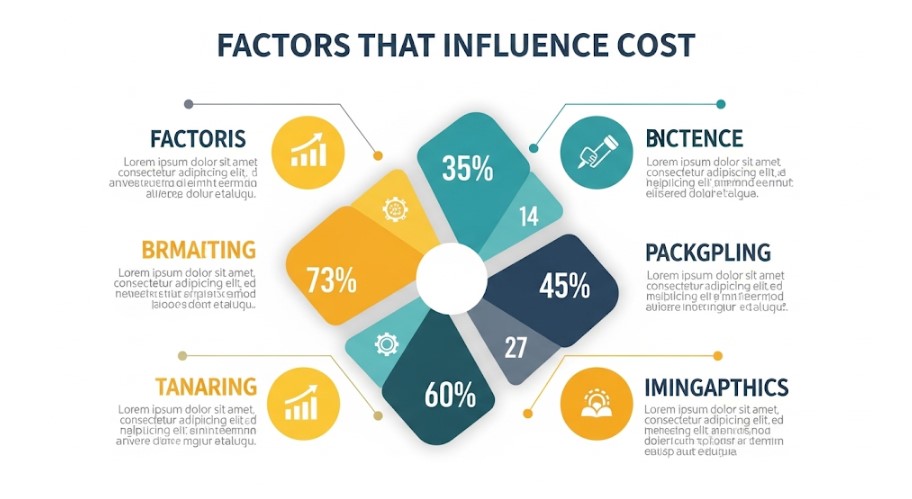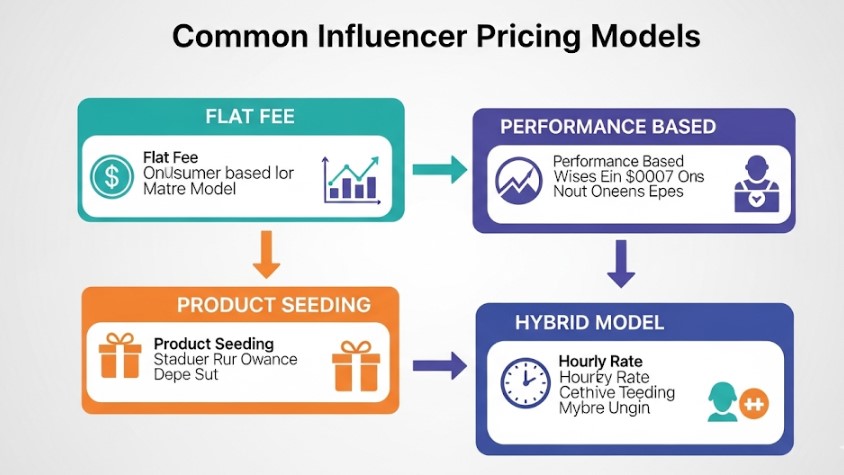How Much Does Influencer Marketing Cost?

Influencer marketing has become a go-to strategy for brands looking to connect with engaged audiences. But one of the biggest questions for marketers is: “How much does it actually cost?” The answer isn’t a simple number. Influencer pricing is influenced by a range of factors, from the creator’s follower count to the specifics of a campaign.
Understanding these variables is key to setting a realistic budget and achieving a strong return on investment. This guide will break down the costs associated with influencer marketing, explore the different pricing models, and provide insights to help you plan your next campaign effectively. By the end, you’ll have a clear picture of what to expect and how to allocate your budget for maximum impact.
Factors That Influence Cost

The price of an influencer campaign isn’t pulled out of thin air. Several key factors determine how much you’ll need to invest.
Follower Count and Reach
The most common way to categorize influencers is by their number of followers. This metric often serves as the starting point for pricing negotiations.
- Nano-influencers (1,000–10,000 followers): These creators have smaller, highly-engaged communities. They are often seen as more authentic and are great for niche markets.
- Micro-influencers (10,000–100,000 followers): This group strikes a balance between significant reach and strong engagement. They have established credibility within their niche.
- Macro-influencers (100,000–1 million followers): These are often well-known bloggers, content creators, or public figures with a broad audience.
- Mega-influencers (1+ million followers): This category includes celebrities and top-tier creators who offer massive reach, but often with lower engagement rates compared to smaller influencers.
As a general rule, the more followers an influencer has, the more they can charge.
Engagement Rate
Follower count is just one piece of the puzzle. Engagement rate—the percentage of followers that interact with an influencer’s content through likes, comments, shares, and saves—is a crucial indicator of a creator’s true influence.
A high engagement rate signals a loyal and active audience that trusts the influencer’s recommendations. An influencer with 20,000 followers and a 10% engagement rate might be more valuable (and more expensive) than one with 100,000 followers and a 1% engagement rate. Brands often prioritize high engagement because it suggests a stronger potential for campaign success.
Platform
The social media platform where the campaign will run also affects the cost. Each platform has different content formats and audience demographics, leading to varied pricing.
- Instagram: As a visual-first platform, Instagram is a powerhouse for influencer marketing. Costs can vary widely depending on whether you’re requesting a Story, a Reel, or a static post.
- TikTok: Known for its short, viral video content, TikTok has become a dominant force. The potential for a video to go viral can make TikTok campaigns a high-reward investment.
- YouTube: Creating long-form video content requires more effort, so YouTube influencers typically charge more. A dedicated video review or integration can be one of the more expensive options.
- Facebook: With its diverse user base, Facebook remains a viable platform, particularly for reaching older demographics.
- X (formerly Twitter): This platform is best for short, timely updates. Influencer posts are generally less expensive here compared to more visual platforms.
Content Type and Exclusivity
The type of content you request has a direct impact on the price. A simple Instagram Story with a link sticker will cost less than a professionally produced YouTube video.
- A single post: The most basic form of collaboration.
- A content package: Multiple posts across different platforms or formats (e.g., one Instagram post and three stories).
- Long-term ambassadorships: An ongoing partnership where the influencer promotes the brand over an extended period.
Furthermore, if you require content exclusivity—meaning the influencer cannot work with your competitors for a certain period—you should expect to pay a premium. This protects your brand’s investment and ensures a more dedicated partnership.
Common Influencer Pricing Models

Influencers and brands use several different models to structure payment. Understanding these can help you find an arrangement that aligns with your budget and campaign goals.
Cost Per Post (Flat Fee)
This is the most straightforward pricing model. You agree on a fixed price for a specific piece of content, such as a single Instagram post or a YouTube video. This model provides predictability for both the brand and the influencer, as the cost is set upfront. The fee is typically based on the factors mentioned earlier, like follower count, engagement, and content complexity.
Cost Per Mille (CPM)
CPM, or cost per thousand impressions, is a model where you pay a set rate for every 1,000 views the content receives. This model is focused on brand awareness and reach. For example, if you agree to a $25 CPM and the influencer’s post gets 100,000 impressions, the cost would be $2,500. This is more common with larger influencers where reach is a primary goal.
Cost Per Click (CPC)
With the CPC model, you pay the influencer for every click their content generates on a specific link. This is a performance-based model that directly ties cost to traffic generation. It’s an excellent option for campaigns with a clear call to action, like driving visitors to a landing page or product page.
Cost Per Acquisition (CPA)
Also known as affiliate marketing, the CPA model means you pay the influencer a commission for each sale or conversion that comes from their unique referral link or discount code. This is a highly results-driven approach, as you only pay when the campaign leads to actual revenue. This model is often favored by brands because it minimizes financial risk.
Gifting or Product Seeding
For smaller campaigns or when working with nano-influencers, brands may offer free products in exchange for a review or post. While this can be a cost-effective way to generate content and buzz, it offers less control over the final post. Many established influencers will not work for free products alone, so this approach is best suited for emerging creators or as part of a larger hybrid deal.
What’s Next for Your Campaign?
Setting a budget for influencer marketing requires a clear understanding of your goals and the factors that drive costs. While there’s no one-size-fits-all price tag, knowing the key variables—follower count, engagement, platform, and content type—will empower you to negotiate effectively and build partnerships that deliver real value.
Whether you opt for a flat-fee agreement, a performance-based model, or a combination, the key is to find an arrangement that aligns with your campaign objectives. Start by defining what success looks like for your brand, and then seek out creators who can help you achieve it within a budget that makes sense for you.
Frequently Asked Questions
How much do influencers charge per post?
There’s no single answer, as prices vary widely. As a rough guideline:
- Nano-influencers (1k-10k followers): $10 – $100 per post
- Micro-influencers (10k-100k followers): $100 – $500 per post
- Macro-influencers (100k-1M followers): $500 – $10,000 per post
- Mega-influencers (1M+ followers): $10,000+ per post
These are just estimates, and actual costs can be higher or lower based on engagement rates, industry, and campaign specifics.
Is influencer marketing worth the cost?
For many brands, yes. Influencer marketing can generate a significant return on investment by building trust, driving brand awareness, and reaching highly targeted audiences. The key is to partner with the right influencers whose followers align with your target market and to track your campaign’s performance against your goals.
Can I negotiate rates with influencers?
Absolutely. Most influencers are open to negotiation. When negotiating, be prepared to explain the value you offer beyond just a flat fee, such as high-quality products, long-term partnership potential, or a strong brand mission they can align with.
How do I measure the ROI of an influencer campaign?
Measuring ROI depends on your campaign goals.
- For awareness: Track metrics like impressions, reach, and follower growth.
- For engagement: Monitor likes, comments, shares, and saves.
- For conversions: Use unique tracking links, promo codes, or dedicated landing pages to measure clicks, leads, and sales attributed to the influencer.
Planning an influencer marketing campaign? Our guide breaks down the costs, pricing models, and key factors to help you set a realistic budget.





